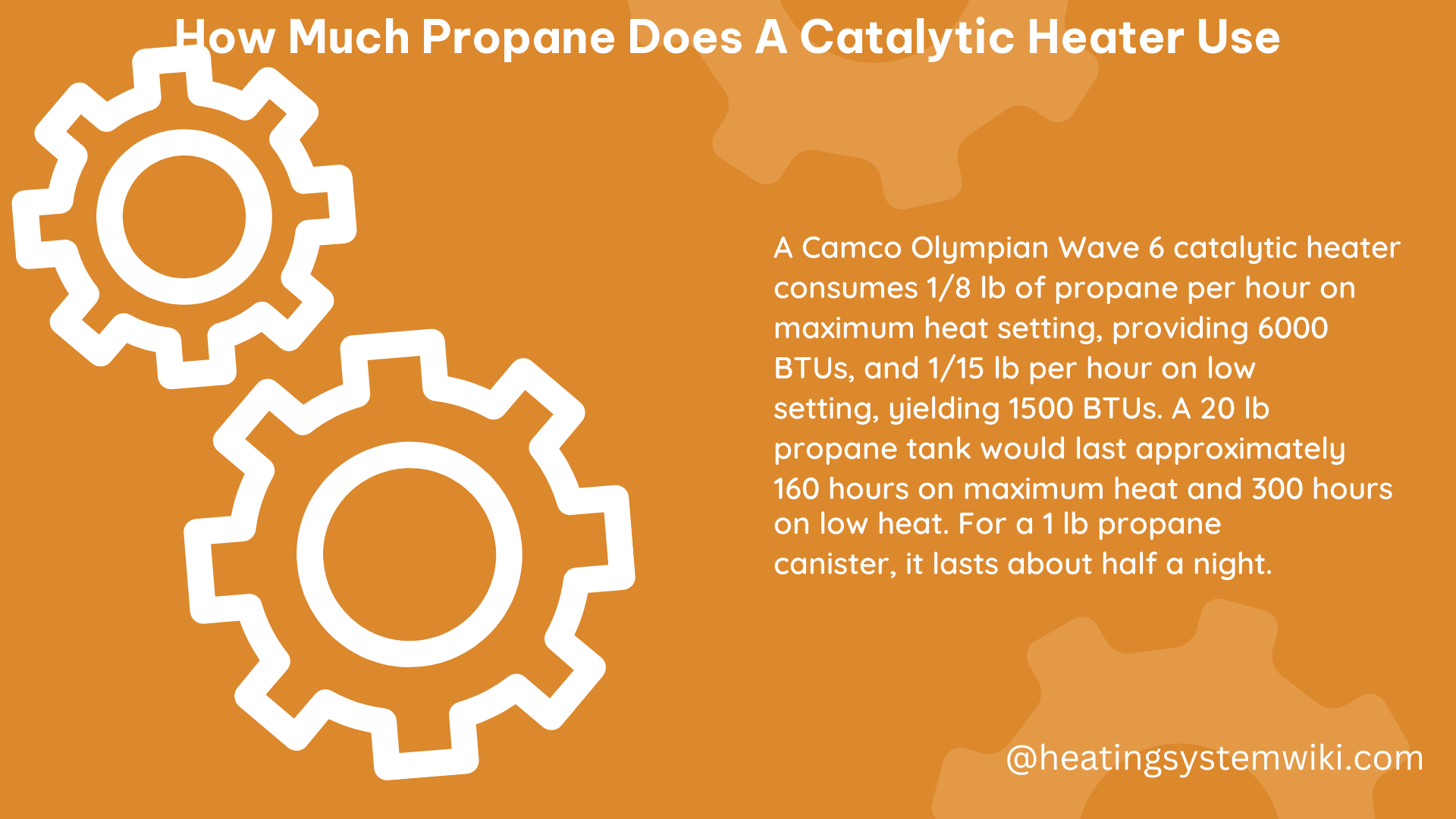Catalytic heaters are renowned for their efficient use of propane, providing a flameless heat source that consumes fuel at a slower rate compared to traditional flame-type heaters. This guide delves into the intricate details of propane consumption for various catalytic heater models, empowering you with the knowledge to make informed decisions and maximize the performance of your heating system.
Understanding Catalytic Heater Propane Consumption
Catalytic heaters utilize a unique heating mechanism that sets them apart from conventional flame-based heaters. The catalytic process involves a chemical reaction that generates heat without an open flame, resulting in a more efficient and controlled heat output. This efficiency translates to a lower propane consumption rate, making catalytic heaters a cost-effective and eco-friendly heating solution.
Olympian Wave 6 Heater by Camco
The Olympian Wave 6 heater, a popular model from the Camco brand, demonstrates the impressive efficiency of catalytic heating technology. On its maximum heat setting, the Olympian Wave 6 consumes approximately 1/8 lb of propane per hour. This means that a 20 lb propane tank can power the heater for around 160 hours on the highest setting.
When operated on the low setting, the Olympian Wave 6 heater uses an even more efficient 1/15 lb of propane per hour, allowing it to run for approximately 300 hours on a single 20 lb propane tank.
Martin Catalytic Heater
Another renowned catalytic heater is the Martin model, which showcases exceptional propane efficiency. According to the manufacturer, the Martin catalytic heater can operate for around 10 hours on a 1# propane cylinder while providing 1,500 BTUs of heat.
However, independent testing has revealed that the actual BTU output of the Martin heater is closer to 2,159.1 BTUs per hour, rather than the claimed 1,500 BTUs. This discrepancy highlights the importance of verifying manufacturer claims and conducting real-world performance evaluations.
Despite the higher actual BTU output, the Martin catalytic heater still maintains a commendable efficiency rate, demonstrating the advantages of catalytic heating technology.
Factors Affecting Propane Consumption

Several factors can influence the propane consumption of a catalytic heater, and understanding these variables can help you optimize the performance and runtime of your heating system.
Heat Output Settings
The heat output setting of a catalytic heater directly correlates to its propane consumption. As mentioned earlier, the Olympian Wave 6 heater uses 1/8 lb of propane per hour on its maximum setting, while the low setting reduces consumption to 1/15 lb per hour. Adjusting the heat output to match your heating needs can significantly extend the runtime of your propane tank.
Ambient Temperature
The ambient temperature of the environment can also impact the propane consumption of a catalytic heater. In colder conditions, the heater may need to work harder to maintain the desired temperature, resulting in increased propane usage. Conversely, in warmer environments, the heater may consume less propane to achieve the same level of heating.
Insulation and Airflow
The insulation and airflow within the space being heated can also influence the propane consumption of a catalytic heater. Well-insulated and sealed spaces require less heating effort, leading to lower propane usage. Ensuring proper ventilation and airflow can also help optimize the heater’s efficiency and reduce propane consumption.
Heater Size and BTU Output
The size and BTU output of the catalytic heater play a crucial role in determining its propane consumption. Larger heaters with higher BTU ratings will generally consume more propane to maintain the desired heat output, while smaller, more efficient models may use less fuel.
Proper Ventilation and Safety Considerations
While catalytic heaters are designed to be efficient and safe, it is essential to follow proper ventilation guidelines and safety protocols when using these devices.
Catalytic heaters consume oxygen and produce carbon monoxide (CO) as a byproduct of the heating process. Adequate ventilation is crucial to ensure a well-oxygenated environment and to prevent the buildup of harmful CO levels. It is recommended to use catalytic heaters in well-ventilated areas, such as with a window cracked open, to maintain a safe and healthy indoor environment.
Additionally, each catalytic heater model undergoes rigorous safety, performance, and quality testing before leaving the factory. This ensures that the heater meets or exceeds industry standards and delivers years of reliable, stress-free service when used according to the manufacturer’s instructions.
Conclusion
Catalytic heaters offer a highly efficient and cost-effective heating solution, thanks to their unique flameless heating technology. By understanding the propane consumption rates of popular catalytic heater models, such as the Olympian Wave 6 and the Martin heater, you can make informed decisions and maximize the performance and runtime of your heating system.
Remember to always prioritize safety by ensuring proper ventilation and following the manufacturer’s guidelines when using catalytic heaters. With this comprehensive guide, you can confidently navigate the world of catalytic heating and enjoy the benefits of efficient, low-cost, and eco-friendly warmth.
References:
– How long will this Olympian heater run on a 20 lb propane tank?
– Excessive propane usage in Camco Wave 3 heater
– Portable Catalytic Camping Heater
– Camco Olympian Wave 6 Catalytic Heater
– Anyone using the Mr. Heater “Journey” Catalytic Heaters?
